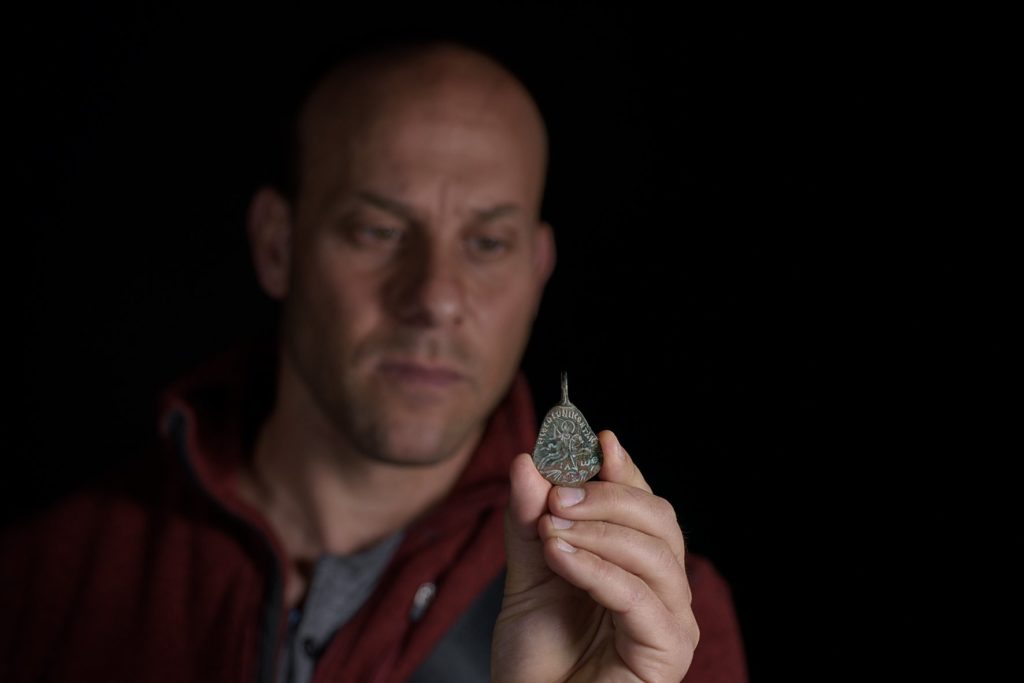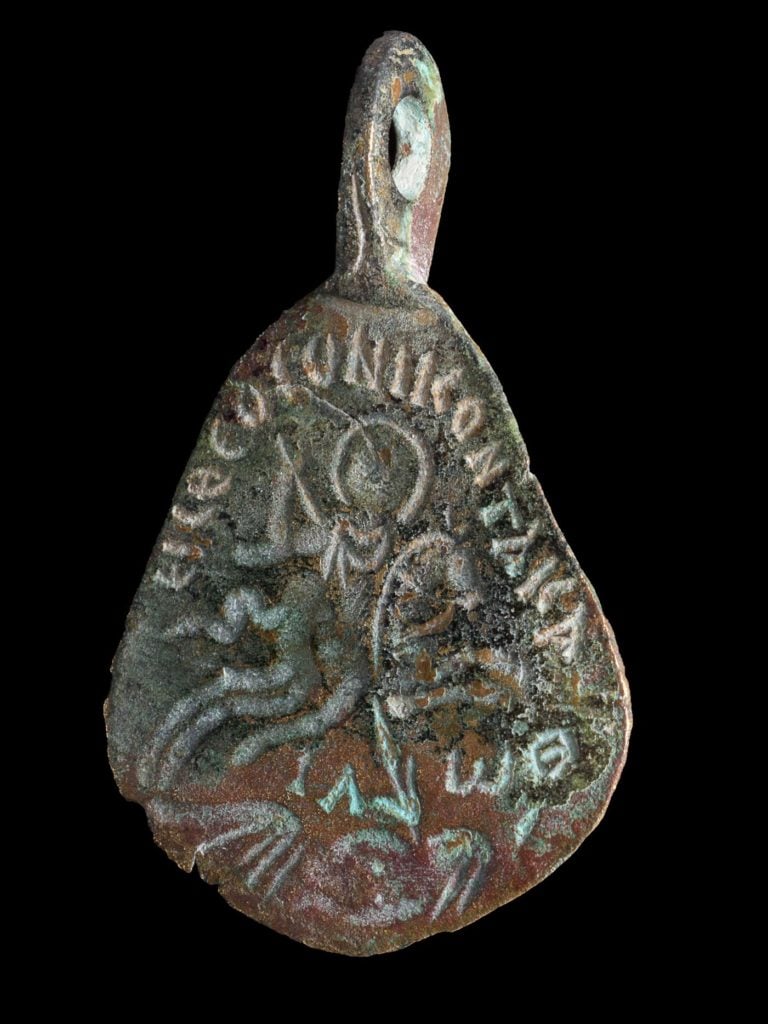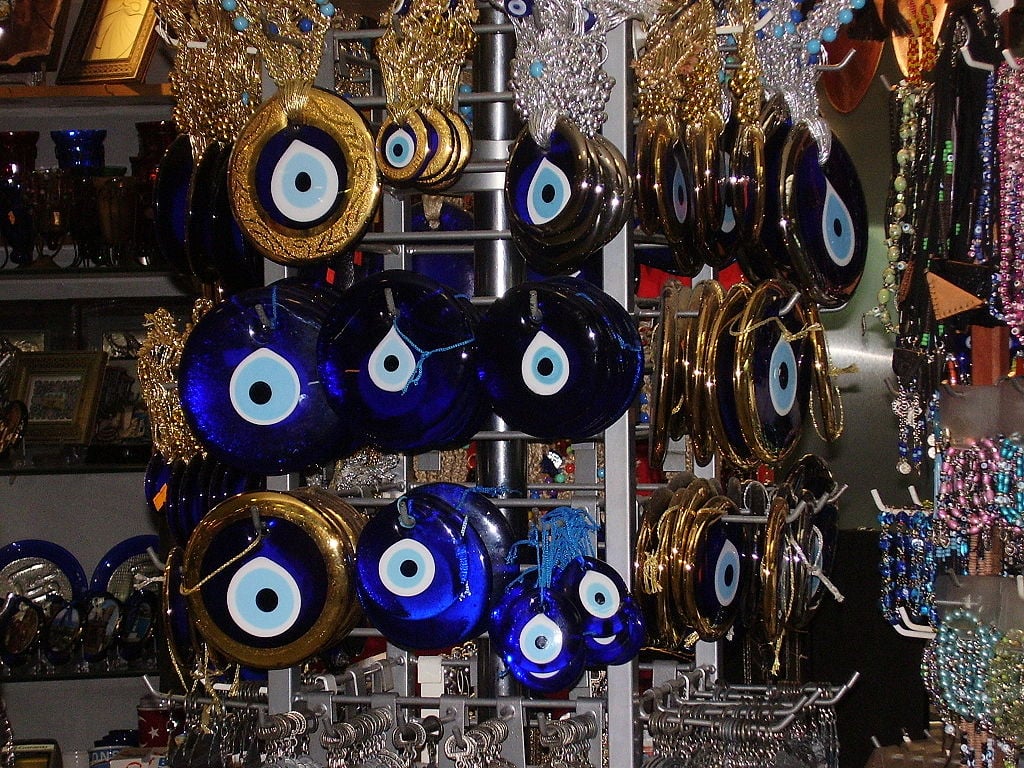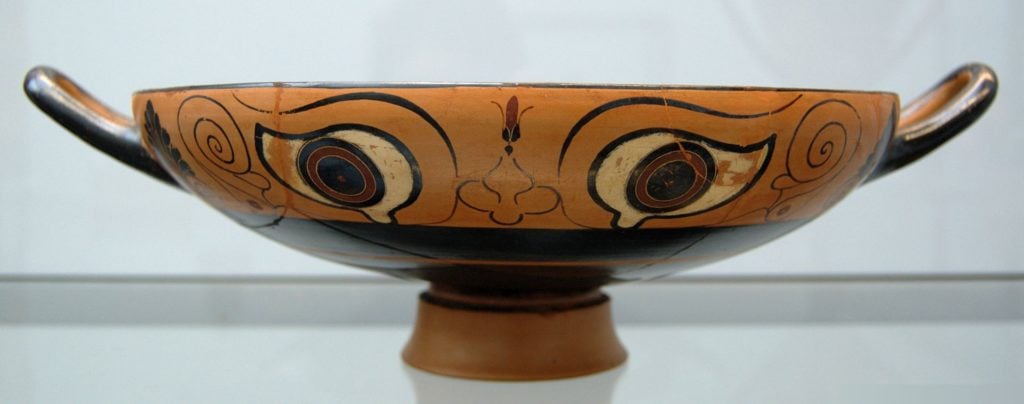
Officials from the Israeli Antiquities Authority recently displayed for the first time a 5th-century Evil Eye pendant that served as a talisman against evil which had been unearthed some time ago in the Galilee region.
The pendant had unfortunately been in private hands but its owner recently decided to share the amazing object with the world by donating it to the IAA.
The necklace and pendant, dating back around 1,500 years ago was uncovered 40 years ago in the village of Arbel in the Galilee by one of its first residents, the late Tova Haviv, according to a press release from the IAA.
It was recently handed over to the Israel Antiquities Authority by a family member. The pendant, which has a triangular shape, shows the figure of a person with a halo riding a horse.

The rider is depicted in the act of throwing a sphere at a female figure on the ground, surrounded by the inscription, in Greek, reading “The One God who Conquers Evil.” Under the horse, the Greek letters I A W Θ appear, which the equivalent of Jewish divine name of Y-H-W-H, or God.
The opposite side of the object depicts an eye pierced by arrows and surrounded by dangerous animals – two lions, a snake, a scorpion and a bird – as well as another Greek inscription reading “One God.”
According to Dr. Eitan Klein, the deputy director of the IAA Antiquities Theft Prevention Unit, the amulet is “part of a group of fifth–sixth-century CE amulets from the Levant that were probably produced in the Galilee and Lebanon.

“This group of amulets is sometimes called ‘Solomon’s Seal’ and the rider is depicted overcoming the evil spirit – in this case, a female identified with the mythological figure Gello/Gyllou, who threatens women and children and is associated with the evil eye.
“The eye on the reverse is identifiable as the evil eye, being attacked and vanquished by various means. The amulet was therefore probably used to guard against the evil eye, possibly to protect women and children,” he adds.
Significantly, during the Byzantine period, Arbel was a Jewish settlement, which was often mentioned in the Talmud, and the artifact dates back to that exact period. And perhaps most remarkably, the presence of the talisman there suggests that even the Jews of that period wore amulets of this type for protection against the evil eye and demons.

In the statement, the IAA says “We thank the amulet’s donor for demonstrating good citizenship! Objects of this kind tell the story of Israel’s history and heritage and they belong to all the citizens of Israel, both legally and in terms of their cultural value.”
The evil eye, or Mati, in Greek, is an ancient Mediterranean symbol that is part of a superstitious curse or legend.
It has historically been believed that a curse can be cast on a person by a malevolent glare, which is usually given to a person when one is unaware. The concept of the evil eye dates back at least to Greek classical antiquity, to 6th century BC, where it appeared on Chalcidian drinking vessels, known as ‘eye cups’, as a type of apotropaic magic (something that has the power to deflect evil).

People from many cultures around the Mediterranean believe that receiving the evil eye will cause misfortune or injury, while others believe it to be a kind of supernatural force that casts or reflects a malevolent gaze right back upon those who wish harm upon others (especially the innocent).
Talismans or amulets created to protect against the evil eye are usually called “evil eyes” themselves and can appear on almost any object whatsoever— from a glass bead to the prow of a Mediterranean fishing boat.
Older iterations of the symbol were often made of ceramic or clay. However, following the beginning of the production of glass beads in the Mediterranean region in approximately 1,500 BC, evil eye beads were popularized with the Phoenicians, Persians, Greeks, Romans.
Blue was likely used as it was a relatively easy color to create in glass; however, modern evil eyes can come in a range of colors, although most by far are a piercing cobalt blue.
The idea expressed by the term causes many different cultures to pursue protective measures against it, with around 40% of the world’s population currently believing in some form of the power of the evil eye.
The concept and its significance vary widely among different cultures, but it is especially prominent in the Mediterranean and West Asia. The idea does appear multiple times in Jewish rabbinic literature, so perhaps the existence of the Israeli pendant should not come as a surprise.
While the Egyptian Eye of Horus is a similar symbol, it represents protection and good health, very unlike the Greek evil eye talisman, which specifically protects against malevolent gazes.
Similarly, the Eye-Idols (c. 8700–3500 BC) excavated at the Tell Brak Eye Temple are believed to have been figurines offered to the gods, and according to the Metropolitan Museum of Art, they are unrelated to a belief in the evil eye.
Regarding Greek traditional beliefs, the evil eye is far and away the largest Greek superstition. It is believed that someone can cast the evil eye onto another person out of envy (either good or bad) and jealousy.
You are said to be “matiasmenos” (“the evil eye has been cast upon you”) if you are dizzy or have a headache and yawn a lot. Most Greeks feel that they are under the spell of the evil eye if they are too beautiful, or too rich.
The good news is that you can have the “spell” broken by someone who knows how to conduct a special ritual with oil, water and prayers. Or, amazingly, now with the help of modern technology, even by using an app on your cellphone.
No matter which category they might believe they are in, many Greeks run to the “Xematiastra,” the woman who knows how to send away “To mati,” to find relief from the ancient curse.
See all the latest news from Greece and the world at Greekreporter.com. Contact our newsroom to report an update or send your story, photos and videos. Follow GR on Google News and subscribe here to our daily email!



